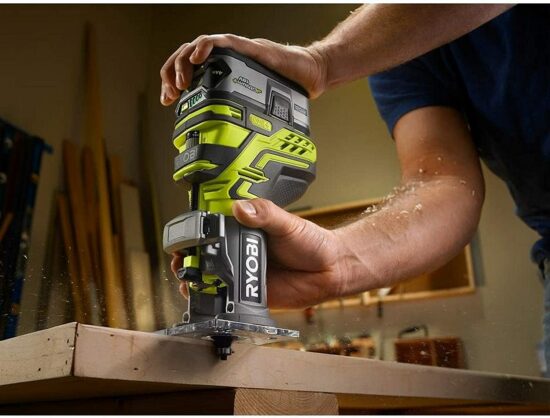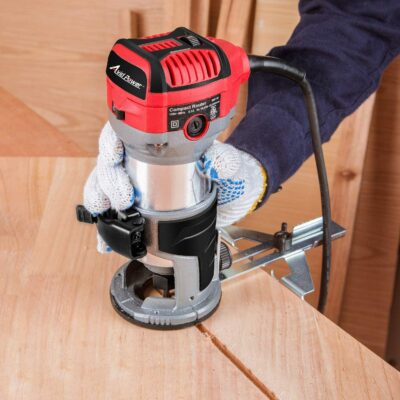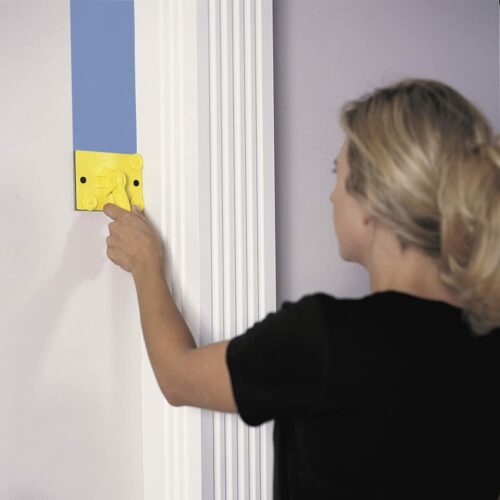One of the most important tools in any woodworker’s workshop is the router. If you make furniture or cabinets on a regular basis, it shouldn’t be hard for you to agree with me.
It’s a tool that can be used in almost any way you can think of. As soon as you think you know everything a router can do, you find out that it can do even more amazing things.
You don’t have to go far to find out this. Just go to another woodworker’s shop or do some research online, and you’ll find something you’ve never done with your router.
As a beginner, once you know how to use this tool and what it can do, you’ll wonder why you didn’t start using one sooner.
Table of Contents
Guide To Using A Router Tool
If this is your first time routing, I’ll start by telling you what the tool is and what it does.

What is a tool for routing?
Well, a router tool is just a motor with a bit that spins at a very high speed. Its main job is to cut or hollow out hard materials like wood or plastic.
That means that if you are a woodworker, you will find many ways to use it in your projects.
It can be used by hand, or it can be attached to a table called a “router table.” Now that it’s on the table, you don’t have to touch the tool.
All you have to do is move your workpiece or stock through the fast-spinning bit sticking out of a hole in the table.
Putting the router on a table also makes it more stable, which lets you do more precise work with it.
Router Types
The basic form of a router tool is a motor that spins a cutting bit, but it comes in two main forms that give the user more control over the tool.
There are two main kinds: fixed-base and plunge-base. But there are also other styles that are named after the things they have.
There are also laminate trimmers with different speeds and CNC routers. But all of these fall into two main categories: plunge and fixed base.
You don’t have to set the cut depth before turning on the plunge-base router. The base of the tool sits flat on the face of the stock being routed. The router is turned on, and the fast-spinning bit is lowered into the stock.
So, it is called a plunge-base router because the base can be set flat on the work surface and the cutter can be lowered to plunge into the work.
Before turning on the motor of a fixed-base router, the cut depth is set. Then, one side of the base plate is placed flat on the stock that hangs over the edge. This keeps the cutter from touching the stock until the motor is turned on and the cutter is slowly moved through the edge.
With a fixed base unit, you can also plunge-cut or route through the middle of a workpiece by putting the base or sole plate at an angle on top of the stock and the cutting bit above the stock.
To continue routing, the motor is turned on and the bit is slowly rocked into the stock.
What You Need to Know About Router Bits or Cutters

Without the right router bits, it doesn’t matter what kind of router you have or how expensive or complicated it is.
With the bits you have, you can cut your stock into the shapes, profiles, and patterns you want.
When you have more types of bits, you can make more complex patterns, shapes, and profiles. So, when you go shopping for router bits, it’s best to buy the whole set so you have most of the bits you’ll need.
But you might not need all the bits. There are up to 16,000 different kinds of bits, and I don’t think anyone needs all of them. Most of the time, you’ll use straight bits and bits that curve over. It all depends on the projects you’re working on.
Most router bits are put into groups based on what they are made of. There are bits made of high-speed steel (HSS), bits with carbide tips, and even bits made of solid carbide.
Aside from the material they are made of, they are also divided into edge bits, non-edge bits, and anti-kickback bits, based on how they are used.
Edge bits are made to make moldings. They have a small wheel bearing that rolls along the edge of the workpiece and presses up against the workpiece, acting as a fence.
Most of the time, non-edge bits are used when the router is on a router table because the workpiece needs to be guided through the bit.
Every woodworker should know how to use a router.
As I’ve said before, if you make furniture or cabinets, the router will be one of your most-used tools.
But what can you really do with it?
Using a router to make edges and trims
This is a fun and beautiful way that a router can be used in a workshop. You can cut and shape any kind of molding with it because it can cut different types of profiles.
As long as you have the right piece, you can do almost anything.
Grooves and rebates need to be cut.
A router is the best tool to use if you want to cut grooves and rebates. Most of the time, grooves and rabbets are used in cabinet-making to make door and window jambs. To get things going, all you need is a rabbet bit.
Round off the edges
You can cut and smooth any rough edges on your stock with a router, whether the wood is straight or curved.
Cutting Dadoes
When you put a dado blade on a table saw, you can make it through dadoes. A router, on the other hand, makes it easy to make both through and blind dadoes.
Making Door Hinge Cutouts
If you want the hinges of a door to be flush with the edge of the door, you need to recess the hinges. One of the many ways a router tool can be used is to make recessed door hinges work better and look more finished.
It can be used to make room for door hinges that are set into the door.
Wood Plane
I didn’t think this was possible at first, but it turns out that a router tool can also be used to plane and thickness wood. Just build a routing jig and mount it on it, and you can use it to plane, thickness, and even join any stock of wood.
Cut Plans and Patterns
A router is the best tool for making cuts in wood, plastic, or acrylic to make patterns. You can use it to trace the outline of the original piece so that you can make the same pattern, design, or shape on your stock.
Cut wooden inlays
With wood inlays, you can add designs to your woodworking projects. For example, you could add a logo, a mark, or a symbol to make your piece look even better.
No matter what kind of inlay you want to add to your project or what shape it will be, having a router makes it easy. Using the routing tool, you can easily cut out a space for your inlay.
Drilling
A router tool can also be used to drill holes in your stock that are straight and accurate. For this, plunge-base units work best, but you can also drill through workpieces with a fixed-base unit mounted on a router table.



